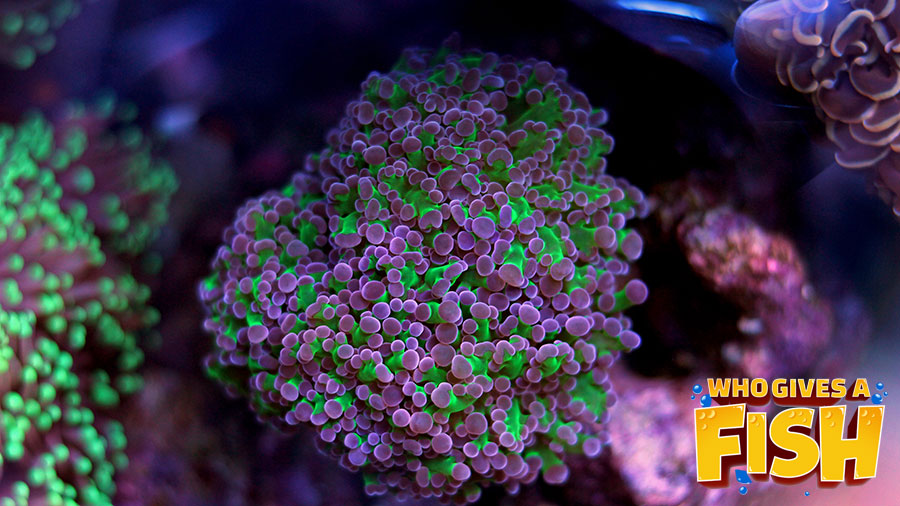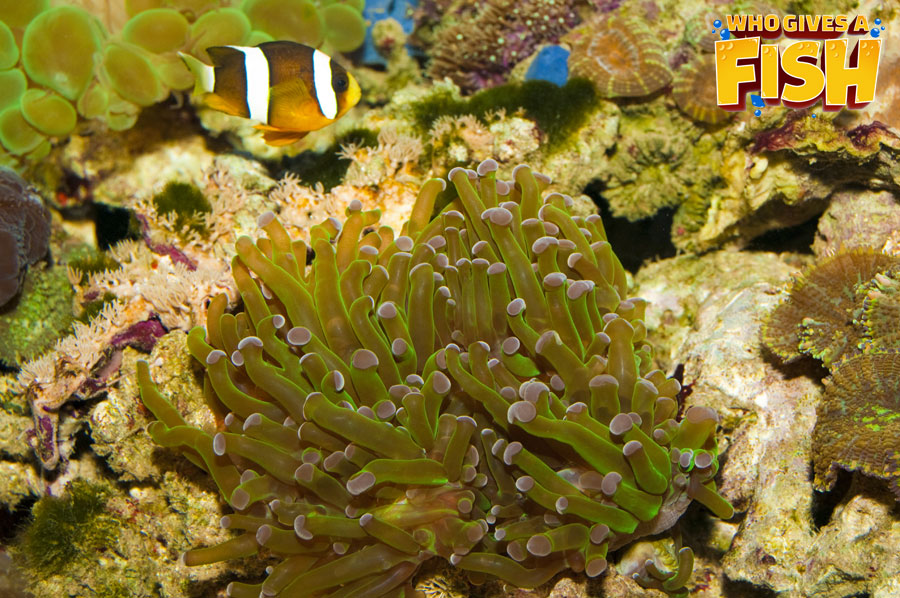Frogspawn Coral
Euphyllia divisa, better known as the Frogspawn Coral is without a doubt one of the most popular corals among marine hobbyists. Its is an LPS coral with colorful tentacles and tips that always catch the eye in a tank. Its scientific name is taken from having polyps that divide at the ends, hence the name Frogspawn. It is also known as the Fine Grape Coral, The Zig-Zag Coral, Wall Coral, Honey coral and Octopus Coral.
- Experience Level: Beginner/Intermediate
- Hardiness: Sensitive to water flow for feeding
- Minimum Tank Size: 50 gal (190 L)
- Lighting Needs: Moderate – Strong diffused light – No Direct Light
- Temperature: 74° – 83° F (23° – 28° C)
- Gravity: 1.023 – 1.025
Table of Contents
Introduction
Aquarium Setup
Difficulty
Feeding
Breeding
Social
The identification of the Frogspawn coral comes more from the shape of the polyps than that of their delicate structures. There are a number of colors that the Frogspawn Coral will be seen in. Tentacles can be a yellow, green or brown color with the tips contrasting in either cream, white, lavender or pink. It is often inaccurately called the Grape coral. The difference with the Grape Coral, Euphyllia cristata, is that is doesn’t have branching polyps, instead it has a single contrasting tip from a perfectly straight tentacle.
The Frogspawn Coral is rated easy-moderate to look after. Like others in its genus, it will be one of the first to warm you that you have poor water conditions. Its recommended to be kept by those who have had some experience with LPS corals like that of the Elegance Coral. Some commensal shrimp will be given protection by its tentacles as they branch out and sting corals nearby in order to make room for its own growth and the occasional meal.
The Frogspawn has been well propagated in captivity. It is generally always readily available in stores to purchase and typically one of the cheaper in the Euphyllia species. They are not hermatypic which means they won’t contribute to the structure of the reef. In the wild it will take around 2 years for a colony to repopulate and there is an ever-growing concern about collecting these corals. Some countries have even outlawed the collection of the Frogspawn. Growing these colonies in captivity could prove vital to its wild survival.
Its identification is more determined by the shape of the polyps than that of their delicate structures. They will form large colonies, with corallite walls forming their outer edges and the polyps having the ability to retract back into the corals skeleton. The Frogspawn’s polyps will extend fully during the day but only partially at night time.
Frogspawn tentacles are thick, lumpy polyps with little tips dotted along the length of it, with some branching into double skeletal and single heads. Colors of tentacles will range from a tan-brown color, with the tips being anything from cream, white, lavender, pink, green or yellow. During feeding, individual tentacles will elongate 2 – 3 times their normal length. Some colonies have been found reaching over 3 feet (1 m) wide. Their lifespan is currently unknown.
Aquarium Setup
A well-established reef aquarium is recommended for your Frogspawn coral. Fish will also help by creating some organic matter for them to feed on.
Proper water flow is important for this coral. A strong water flow can cause stress for the polyps and prevent them from extending fully which will stop them from feeding properly. Sufficient lighting is important, with the Frogspawn enjoying non-direct bright light. Do not place them directly under a metal halide as this will damage its polyps leading to RTN (rapid tissue necrosis). Ensure that they do not come in contact with any other corals. This coral can be aggressive especially when its hungry. They have sweeper tentacles that can reach over 10” (25 cm). Feeding them regularly will prevent them from sweeping too far in search for food.
Frogspawn Coral Aquarium and Parameter Checklist
- Minimum Tank Size: 50 gal (190 L)
- Lighting Needs: Moderate – Strong diffused light – No Direct Light
- Temperature: 74° – 83° F (23° – 28° C)
- Specific gravity: 1.023 – 1.025
- Alkalinity Levels: 3.2 – 4.8 MEQ/L (8 – 11 dKh)
- Calcium: 400 – 450 ppm
- Phosphates: 0 (Avoid Phosphates)
- Magnesium Levels: 1200 – 1350
- Strontium Levels: 8 – 10
- Water Movement: Moderate/Turbulent flow
- Tank Region: All areas provided light and water flow requirements are met
Difficulty
The Frogspawn Coral are rated as being easy to moderate to look after. Providing sufficient lighting and a good turbulent water flow that is medium strength is important. The presence and availability of passing food will heavily contribute to their success or failure in your tank. Play with placing coral specimens in different parts of your tank to see which spot is their favorite. This will be seen when they fully extend their polyps during daylight hours and for feeding.
During collection in the wild, they are quite often broken off from parent colonies. A wild specimen may have some soft tissue damage. Their skeleton can be splintered and up into the fleshy polyp area damaged. When choosing a coral for purchase, ensure it has been in the store for about a week or more and has been doing well before taking it. Being cautious like this will help avoid buying any sick or damaged coral as ailments can take some days to show.
Feeding
The Frogspawn Coral, as in other Euphyllia corals and other LPS corals have developed various feeding methods. Planktonic organisms and microscopic food particles will be captured from within the water column. Dissolved organic matter will be absorbed as well. They have a symbiotic relationship with marine algae, also called zooxanthellae from where they can source some of their nutrients as well.
In your home aquarium, mysis shrimp, brine shrimp, krill and other smaller foods can be fed out. Frogspawn corals are able to eat much larger chunks of foods as well. Chop up or dice pieces of shrimp or whole fish and feed the whole thing to the coral. Different parts of the organism have different nutritional value, so providing all of it is important. This coral is generally hungry a lot so plenty of various foods will ensure a healthy coral is maintained.
Breeding
Unfortunately, the Planula Larvae are very vulnerable to being eaten and only very few will survive.
Species in the Euphyllia genus will also reproduce asexually. When in captivity, The Frogspawn Coral will bud off small polyp groups that have little skeletons attached to them. They will also pinch off some of their own tentacles which will then float away and as they are sticky they will attach somewhere new and bring to life a new colony.
In order to propagate these, you will need to start by choosing a healthy Frogspawn Coral that isn’t showing any signs of ill health or stress. Propagation is recommended to be done with an electric saw at least 1 ½ – 2” away from the top. Avoid using bone crushers or scissors as this can cause splintering of the skeleton and polyp damage. Once fragged, attach it to a rock or plug. Coral cement or epoxy are good choices for this. Ensure that the slime from the coral does not come into contact with other corals in your tank as this will damage them. You should always wear gloves when doing this. Ensure new frags have ample water flow. Polyps will remain closed for a while before slowing opening as the new frag heals.




Social
Euphyllia corals can often be quite aggressive when they touch other corals, so they should be kept away from other species. The Frogspawn is known to be peaceful towards it own genus but other genera from its family may be attacked. When they are hungry, they will send their sweeper tentacles out which can reach over 10” (25 cm) in larger colonies. This is a big threat to nearby corals as they have a strong sting to them. Regular feeds will help avoid this, so they don’t feel the need to search for food.
Some commensal shrimp will be given protection by its tentacles as they branch out and sting corals nearby in order to make room for its own growth and the occasional meal. The Frogspawn corals are known to be quite sensitive when placed in aquariums that have large amounts of soft corals, with a specific sensitivity towards various Sinularia species.
Back to top